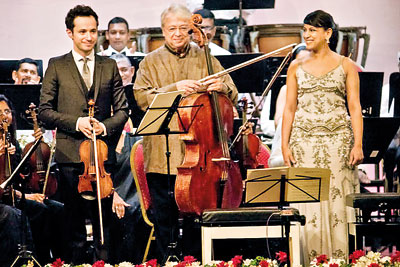On listening to Beethoven’s triple concerto

Gracious trio: Gabriel Le Magadure, Valentin Erben and Shani Diluka. Pic by Srilal Ahangama
The Symphony Orchestra of Sri Lanka (SOSL) marked its 60th season with a concert titled “Virtuosi in Concert” on March 15, at the Ladies’ College auditorium. As the most memorable part of the evening for me was the performance of Beethoven’s Triple Concerto, I consider it a privilege to share some thoughts on this beautiful piece of music.
Beethoven’s Triple Concerto in C Major for cello, violin and piano is not in the basket of the master’s seminal or influential works that are regularly performed, discussed or recorded. For me this is undeserving because whenever I want a retreat from the grand, overpowering and arresting works of Beethoven, the triple concerto is one of my favourite music destinations. Its thematically rich, lyrically charming melodies and the overall buoyancy of impact, take me to remote, sunny places and bring me back to a new serenity. And I never tire of listening to it.
Daniel Barenboim has characterized the triple concerto as a ‘great cello concerto’. It is a format in which the juxtapositional dynamics of soloist and orchestra become the central focus. And what’s more, the unique, underlying beauty of a concerto is the creativity, tension and the drama of this interaction.
In Beethoven’s triple, we have not one but three soloists; this is not only rare but is also a factor that toughens the behavioural and musical expectations from the soloists. Furthermore, the triple concerto inherently embodies a chamber-music disposition as it fosters conversational intimacy between the trio of soloists.
In this overall setting, it is imperative to note that the triple concerto is not a platform for fire-eating virtuosi. Instead, the trio of soloists are expected to be gracious, be listening to one another, submerge their egos and give pride of place to the sanctity of the music.
That’s exactly what I saw, heard and felt at the Ladies’ College auditorium that evening.
The trio Valentin Erben (cellist), Gabriel Le Magadure (violinist) and Shani Diluka (pianist) were exemplary in their approach to the assignment.Individually and collectively they are well regarded and belong in an elite legion of European chamber musicians.Being no strangers to one another, their level of understanding ought to have made the task rewarding.
The trio played as a compact chamber ensemble. There was uplifting support given by SOSL’s orchestra with its spacious expositions and soft, gentle touches notably from woodwinds and strings. SOSL is fortunate to have Japanese conductor Keiko Kobayashi conducting the orchestra with such regularity. If she is not already so regarded, I believe she is entitled to be designated SOSL’s ‘permanent guest conductor’. Kobayashi epitomizes the unflinching devotion to diligence and perfectionism that is intrinsic to the Japanese work ethic.
The first movement was inaugurated by the cellos and basses with a hushed whispering of its phrasing and furtive interspersions of silences.In stark contrast to this shadowy beginning, the full orchestra lost no time in ratcheting up the dynamics to an exciting crescendo that eventually released a delectable theme.
Valentin Erben, waiting in patient anticipation, introduced this theme on the cello to a rhythmic pulse in C major from the first violins.This happens to be the defining moment of this concerto. Beethoven composed seven complete concertos in all.And this is the only one in which the soloist introduces the first theme without some preceding exploratory material.
From then on it was a long, eventful journey strewn with rapid scales, arpeggios and trills; new themes and keys were in the mix. A march-like theme from the orchestra was transformed to a lyrical delicacy by the cello’s solo intervention. Erben the cellist for the most part maintained a stern, granitic composure.Not a muscle in his face twitched. This was in utter contrast to Yo-Yo Ma’s mesmerized, sweat-pouring intensity in his rendering of the triple with Itzak Perlman and Barenboim. And yet Erben’s playing bore the hallmark of outstanding maturity. Indeed, he was the father-figure in the trio.
Gabriel Le Magadure on the violin and Shani Diluka on the piano in turn rendered their respective themes, ideas and passageworks often with astonishing athleticism.While the pianist’s role in this work essentially is that of an accompanist, Diluka’s playing was vivid and animated.A wondrously dramatic coda concluded the first movement.
The second movement began somnolently with muted strings in A Flat Major. Once again, the spotlight fell on the cellist.The beautiful largo was treated with caressing intensity and for once there was that hint of movement in Erben’s facial muscles. His eyelids seemed to open partially as he passed the baton on to the violinist—curiously, he seemed awakened by a lullaby.
The sheer poetry of the largo was only a fleeting prelude seamlessly yielding to the concerto’s majestic finale, “Rondo alla Polacca”, (like a Polish dance).
Here, Beethoven recaptures the theme from the first movement and devotes considerable time navigating us through most of itsterritory.A gypsy tune garnishes the flavour and a cadenza is introduced for the first time.
An orchestral punctuation creates suspense that signals an impending climactic eruption.The trio goes into a frenzy of short-note dialogue at rapid pace. The vivacious soloists are on a sustained tempestuous spree until trills and a punctuation from the piano restores calm. Now the tempo changes when the haunting theme is wrapped in the rhythm of a polonaise (Polish dance). A new momentum gathers as the trio, orchestra and the conductor take us to a buoyant ambience. Beethoven gets generous and licenses the pianist to go full throttle. Diluka accepts with both hands and foot on the pedal. Three pounding chords in C Major announced the concerto’s glorious finale to resounding applause from an ecstatic audience.


